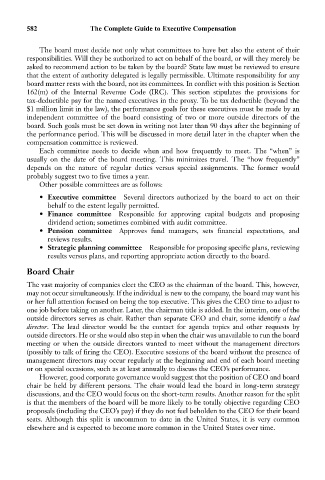Page 596 - Bruce Ellig - The Complete Guide to Executive Compensation (2007)
P. 596
582 The Complete Guide to Executive Compensation
The board must decide not only what committees to have but also the extent of their
responsibilities. Will they be authorized to act on behalf of the board, or will they merely be
asked to recommend action to be taken by the board? State law must be reviewed to ensure
that the extent of authority delegated is legally permissible. Ultimate responsibility for any
board matter rests with the board, not its committees. In conflict with this position is Section
162(m) of the Internal Revenue Code (IRC). This section stipulates the provisions for
tax-deductible pay for the named executives in the proxy. To be tax deductible (beyond the
$1 million limit in the law), the performance goals for these executives must be made by an
independent committee of the board consisting of two or more outside directors of the
board. Such goals must be set down in writing not later than 90 days after the beginning of
the performance period. This will be discussed in more detail later in the chapter when the
compensation committee is reviewed.
Each committee needs to decide when and how frequently to meet. The “when” is
usually on the date of the board meeting. This minimizes travel. The “how frequently”
depends on the nature of regular duties versus special assignments. The former would
probably suggest two to five times a year.
Other possible committees are as follows:
• Executive committee Several directors authorized by the board to act on their
behalf to the extent legally permitted.
• Finance committee Responsible for approving capital budgets and proposing
dividend action; sometimes combined with audit committee.
• Pension committee Approves fund managers, sets financial expectations, and
reviews results.
• Strategic planning committee Responsible for proposing specific plans, reviewing
results versus plans, and reporting appropriate action directly to the board.
Board Chair
The vast majority of companies elect the CEO as the chairman of the board. This, however,
may not occur simultaneously. If the individual is new to the company, the board may want his
or her full attention focused on being the top executive. This gives the CEO time to adjust to
one job before taking on another. Later, the chairman title is added. In the interim, one of the
outside directors serves as chair. Rather than separate CEO and chair, some identify a lead
director. The lead director would be the contact for agenda topics and other requests by
outside directors. He or she would also step in when the chair was unavailable to run the board
meeting or when the outside directors wanted to meet without the management directors
(possibly to talk of firing the CEO). Executive sessions of the board without the presence of
management directors may occur regularly at the beginning and end of each board meeting
or on special occasions, such as at least annually to discuss the CEO’s performance.
However, good corporate governance would suggest that the position of CEO and board
chair be held by different persons. The chair would lead the board in long-term strategy
discussions, and the CEO would focus on the short-term results. Another reason for the split
is that the members of the board will be more likely to be totally objective regarding CEO
proposals (including the CEO’s pay) if they do not feel beholden to the CEO for their board
seats. Although this split is uncommon to date in the United States, it is very common
elsewhere and is expected to become more common in the United States over time.

